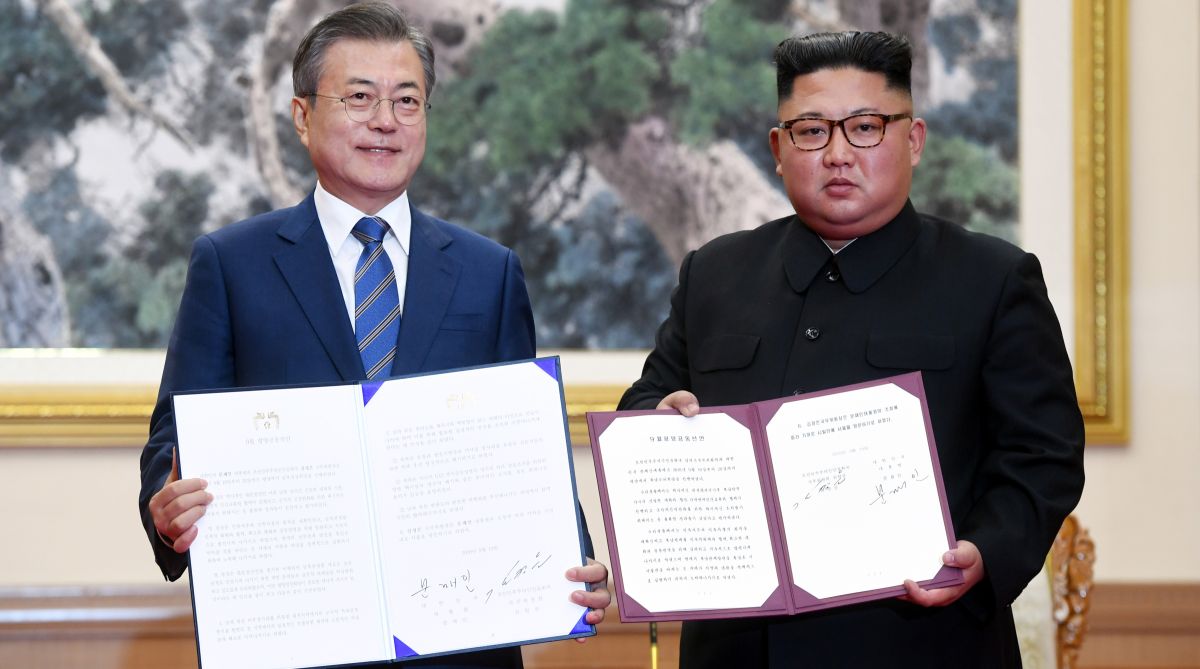North Korea says bolstering self-defensive capabilities to deter rivals
Bolstering self-defensive capabilities is an essential requirement for deterring rivals' provocative attempts and ensuring national security.
Kim Jong-un said he and Moon Jae-in agreed to remove all nuclear weapons and threats from the Korean Peninsula

South Korean President Moon Jae-in (L) and North Korean leader Kim Jong Un (R) pose for photographs during a signing ceremony after their summit at Paekhwawon State Guesthouse in Pyongyang on September 19, 2018. (Photo: AFP)
North Korea agreed to take additional steps toward making the Korean Peninsula free of nuclear weapons and threats of armed conflict Wednesday, in an apparent gesture to restart its denuclearization talks with the United States. The agreement came in the historic Pyongyang summit between its leader Kim Jong-un and South Korean President Moon Jae-in.
“The South and the North also discussed denuclearization steps for the first time,” Moon said of his talks with Kim in a joint press conference held at the North’s state guesthouse Paekhwawon.
Advertisement
“The North has agreed to permanently shut down its Dongchang-ri missile engine testing facility and missile launch pad under the participation of experts from related countries,” the South Korean president said in the press conference, broadcast live in Seoul.
Advertisement
Kim said he and Moon agreed to remove all nuclear weapons and threats from the Korean Peninsula.
OPINION | Talk-time on Korea-I
“The September declaration will open a higher level for the improvement in relations (between the South and the North) … and bring closer the era of peace and prosperity,” Kim said of his agreement signed with Moon after their two-day talks in Pyongyang.
In the joint declaration, later released by Seoul’s presidential office Cheong Wa Dae, the North agreed to take additional denuclearization steps following corresponding steps by the United States to reward the impoverished North.
“The North expressed its willingness to continue taking additional steps, such as the permanent shutdown of the Yongbyon nuclear facility, should the United States take corresponding measures under the spirit of the June 12 North Korea-US joint statement,” it said, referring to the agreement reached by US President Donald Trump and Kim in their bilateral summit held in Singapore.
Pyongyang is said to be demanding early rewards for denuclearization steps it has taken so far, while Washington continues to stress the importance of maximum pressure and sanctions against the North until the communist state fully denuclearizes.
OPINION | Kim, Trump and the nuclear crisis
The North’s offer to take additional denuclearization steps despite any signs of reward from the US is apparently aimed at restarting its denuclearization talks with the US.
The talks have stalled after US President Donald Trump called off a scheduled North Korea trip by his Secretary of State Mike Pompeo, citing what he called a lack of progress in the North’s denuclearization process.
Even before the start of his three-day trip to Pyongyang on Tuesday, the South Korean president said the main objective of his trip was to restart the US-North Korea dialogue.
Moon insisted the North’s agreement also marked the first time for the Koreas to discuss detailed steps to denuclearization.
“I hope the talks between the North and the US quickly resume,” he told the joint press conference.
The agreement signed by the leaders of the two Koreas in Pyongyang also called for steps to further improve inter-Korean ties.
The sides have agreed to begin the work to reconnect their severed railways and roads across the heavily fortified border before the year’s end.
Also, the countries will reopen their joint industrial park in the North’s border town of Kaesong and tourism programs to the North’s Mount Kumgang as soon as “conditions are met,” the agreement said.
The Kaesong complex was shut down in early 2016 as part of Seoul’s unilateral sanctions against the North. Its reopening, however, may violate international sanctions imposed on the communist state.
To further promote reconciliation, the divided Koreas have agreed to soon establish a new joint facility for more frequent and freer reunions of families separated since the end of the Korean War.
The two Koreas technically remain at war as the 1950-53 war ended with an armistice, not a peace treaty.
In a separate agreement signed by their defense chiefs, the Koreas also agreed to a wide range of steps aimed at further reducing military tension on the Korean Peninsula.
Such steps include setting up a 10-kilometer buffer zone along their border where all artillery drills or regiment-level field maneuvers will be prohibited, according to the military agreement.
In their joint declaration, the leaders said the countries have also agreed to quickly launch a joint military committee to review their implementation of such tension-reducing measures and to enable round-the-clock communication to prevent future conflicts.
The two Koreas will continue to jointly take part in international sporting events, including the upcoming 2020 Olympic Games, the leaders said in their Pyongyang declaration.
They will also seek to jointly host the 2032 Summer Olympic Games.
The North Korean leader said he has agreed to visit Seoul in the near future.
Moon said the near future, barring unforeseen conditions, meant before the year’s end.
(The Korea Herald/ANN)
Advertisement